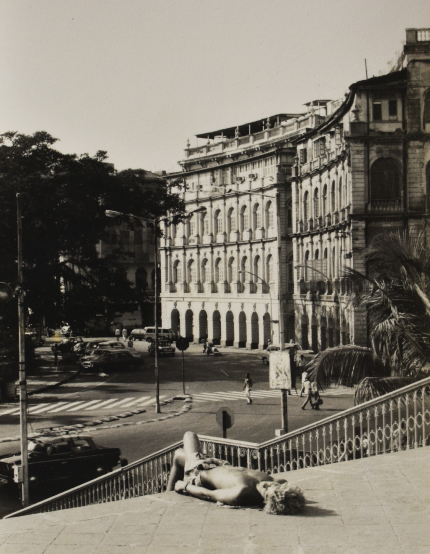
“For me, there is no such thing as the definitive photograph. The very act of fixing an image in a split-shutter-second suggests the dialogue that may ensue… Does the subsequent viewer see it this way? Or have I missed something vital and telling.”
Foy Nissen, A Solitary Moment: The Other India | Museum of Modern Art, Oxford, 1982
Curated by Kamini Sawhney, the show represents over fifty years of work by a lensman who combined a keen sensibility with a quiet discipline. Foy Nissen photographed people, festivals, places and monuments and his images of the city are invaluable to the preservation of Mumbai’s heritage.
It was the 1990s that saw Mumbai’s heritage movement find its voice.
But Nissen was way ahead of it, photographing and documenting his beloved city bit by bit starting way back in the 60’s. He wandered the streets of Fort detailing its combination of Neo-Gothic and Art Deco buildings. He worked his way through the bowels of Crawford market and Bhendi bazaar recording every carved cornice and fountain, and then into Bhuleshwar and Girgaum capturing the quaint homes of Khotachiwadi....all the way up to Bandra with its winding streets and colonial bungalows. His meticulous work provided the base for Mumbai’s first heritage list which then helped develop legislation to preserve the city’s heritage precincts.
The “internet of his times” Foy Nissen had writers, artists, conservationists and scholars all gravitate to his home Olympus, in Altamount Road to learn more about the city. They would often be swept off to all his favouriate haunts on his Vespa scooter. Most writers on the city acknowledge a debt of gratitude to this chronicler of the what was once christened the urbs prima in India, for being so generous with his scholarship. His close friendship with artists seems to have been inspirational with the celebrated British artist Howard Hodgkin creating Foy Nissen’s Bombay, a work that has provided the title of this exhibition.
The exhibition celebrates not only a great historian of this city but also one of its most talented photographers. It was not just Mumbai that Nissen recorded in loving detail. He travelled to many parts of the country and beyond, from Pune, and Goa to Madhya Pradesh, Rajasthan, Sikkim and Nepal. His lens uncovered not just the beauty of monuments but of people as well, even as each was often juxtaposed with the other. The photographs capture the delicacy of a moment, whether it is a hamal lying wearily in his basket, a koli woman looking forward to her first sip of tea or a young girl intently examining her doll. His camera seems to penetrate the soul of his subject seeking that defining emotion– sometimes pensive or lonely at other times tender or playful and in some instances just plain bored.
This exhibition also celebrates the generous gift by the estate of Foy Nissen, of the complete range of his photographic work to the Jehangir Nicholson Art Foundation. The collection of gelatin prints, slides and negatives that reflect over fifty years of Nissen’s scholarship and documentation are held in safekeeping for the benefit of this great city and its people.
Exhibition Catalogue:
Foy Nissen's Bombay: Photographs from the archives of Foy Nissen
Price: 500.00 (Shipping cost not included)
Year of publication: 2019
Size: 27 x 23 cms
Type: Paperback
Pages: 109 pages
ISBN: 978-81-928046-9-9
With an essay from Gautam Patel.
To purchase: Write to us at connect@jnaf.org

Foy Nissen (1931- 2018)
Foy Nissen was of Danish descent. His great grandfather Georg Christian Kastrup Nissen left the Danish island of Langeland in 1857 for England in search of a better future. Once there, he found himself on a ship to India instead and landed in Bombay. Unable to make any headway with the British, he worked his way to Gujarat and into the private army of the Maharaja of Baroda. The family did well building a military career for themselves with Georg’s eldest son Ferdinand eventually commanding the Maharaja’s army.
Foy’s father Eric (grandson of Georg) seems to have moved away from Baroda and while Foy was born in Pune in 1931, he grew up in Mumbai studying at the Cathedral and John Connon School. He graduated with a Masters in Art from Christ College, Cambridge and worked for several years at the British Council as their cultural representative. His deep interest in the history of Mumbai and its architecture is reflected in the vast collection of books in his library and his intimate knowledge of the design and sculptural detail of its colonial past. Several writers on the city have acknowledged Nissen’s contribution to their work including Gillian Tindall, author of City of Gold and Suketu Mehta in his book Maximum City.
Though Foy had been behind the lens since 1962, his work rarely appeared in the public domain save for a few articles that were published and four exhibitions including a collection of his photographs that were part of A Solitary Moment: The Other India at the Museum of Modern Art, Oxford, 1982 and a second exhibition at Hull in Yorkshire.